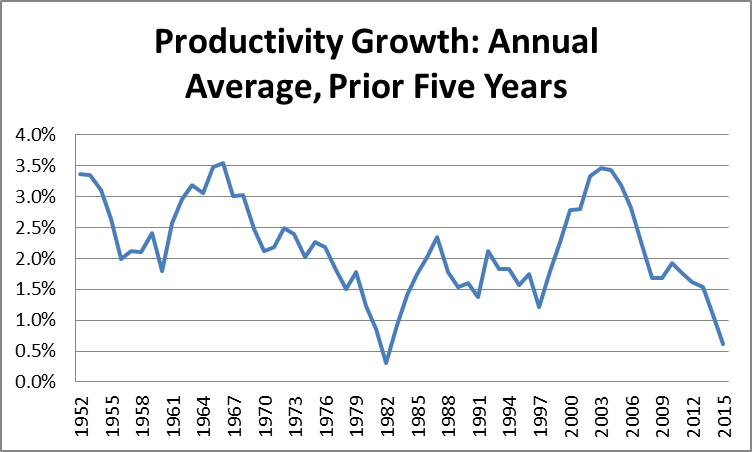From Dean Baker It really is shameful how so many people, who certainly should know better, argue that automation is the factor depressing the wages of large segments of the workforce and that education (i.e. blame the ignorant workers) is the solution. President Obama takes center stage in this picture since he said almost exactly this in his farewell address earlier in the week. This misconception is repeated in a Claire Cain Miller’s NYT column today. Just about every part of the story is wrong. Starting with the basic story of automation replacing workers, we have a simple way of measuring this process, it’s called “productivity growth.” And contrary to what the automation folks tell you, productivity growth has actually been very slow lately. Source: Bureau of Labor Statistics. The figure above shows average annual rates of productivity growth for five year periods, going back to 1952. As can be seen, the pace of automation (productivity growth) has actually been quite slow in recent years. It is also projected by the Congressional Budget Office and most other forecasters to remain slow for the foreseeable future, so the prospect of mass displacement of jobs by automation runs completely counter to what we have been seeing in the labor market.
Topics:
Dean Baker considers the following as important: Uncategorized
This could be interesting, too:
tom writes The Ukraine war and Europe’s deepening march of folly
Stavros Mavroudeas writes CfP of Marxist Macroeconomic Modelling workgroup – 18th WAPE Forum, Istanbul August 6-8, 2025
Lars Pålsson Syll writes The pretence-of-knowledge syndrome
Dean Baker writes Crypto and Donald Trump’s strategic baseball card reserve
from Dean Baker
It really is shameful how so many people, who certainly should know better, argue that automation is the factor depressing the wages of large segments of the workforce and that education (i.e. blame the ignorant workers) is the solution. President Obama takes center stage in this picture since he said almost exactly this in his farewell address earlier in the week. This misconception is repeated in a Claire Cain Miller’s NYT column today. Just about every part of the story is wrong.
Starting with the basic story of automation replacing workers, we have a simple way of measuring this process, it’s called “productivity growth.” And contrary to what the automation folks tell you, productivity growth has actually been very slow lately.

Source: Bureau of Labor Statistics.
The figure above shows average annual rates of productivity growth for five year periods, going back to 1952. As can be seen, the pace of automation (productivity growth) has actually been quite slow in recent years. It is also projected by the Congressional Budget Office and most other forecasters to remain slow for the foreseeable future, so the prospect of mass displacement of jobs by automation runs completely counter to what we have been seeing in the labor market.
